The African Nations Championship is one of the most interesting tournaments in the world for scouts. In it, 16 national teams compete exclusively featuring players who are active in the country’s national championships. For those players, the African Nations Championship is a huge opportunity to showcase their talents, especially for those whose leagues are almost impossible to follow for international scouts because of the lack of footage and data.
The seventh edition of the African Nations Championship was supposed to be held in 2020 and hosted by Ethiopia but the pandemic and other issues forced the CAF to postpone it until 2021 and Cameroon were the hosts. The tournament finished on February 7 and Morocco were the champions after beating Mali in the final.
In this tactical analysis, we aim to uncover six hidden gems who played in this edition of the tournament. We have chosen U23 players except for a 25-year-old goalkeeper and we tried to focus on those players in the lesser-known national teams, so only one of the six players’ teams reached the quarter-finals with the rest being eliminated in the group stage.
The shortlist is composed of one goalkeeper, two defenders, two midfielders and one forward, each one from a different country. For each player, we will provide a scout report and a profile with his basic information and some key stats that highlight some of the reasons why they were chosen for this analysis.
We think these players are ready to play at a higher level and would be very smart acquisitions for any club willing to develop them and give them playing time to prove themselves. Some of the best-known players who have played this tournament in the past are EPL-star Yves Bissouma, Siphiwe Tshabalala and former-Ligue 1 star Papy Djilobodji.
Aishi Salum Manula – 25, goalkeeper, Tanzania
Aishi Manula is a 1995-born Tanzanian goalkeeper who started his career at Azam FC and since 2017 plays for Simba SC in the Tanzanian first division. He has lots of experience with the Tanzanian national team, participating in the African Cup of Nations 2019 and also in African club competitions with Simba.
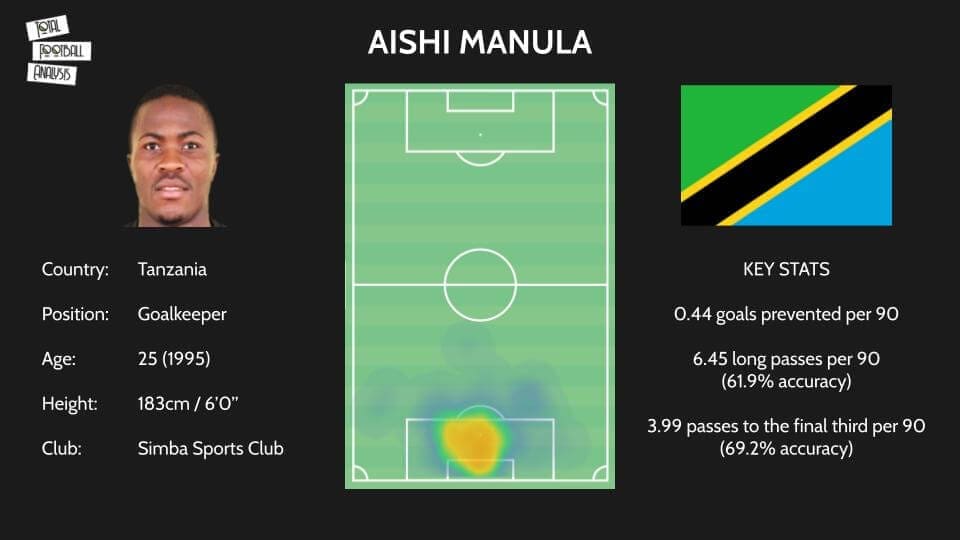
Manula isn’t a very tall goalkeeper (183 cm) but he’s very agile to dive and quick when he leaves his line. His relatively short size makes him a very spectacular goalkeeper when he saves high shots. He’s quick to get down and save low shots. With his great reflexes, Manula has avoided 0.44 goals per 90 in the tournament, conceding just 4 goals from 5.45 expected conceded goals. His grip is good and he doesn’t concede dangerous rebounds. When intercepting crosses or long passes into the box, he times his jumps well and is usually safe but his lack of size may be an issue in some plays.
When building from the back, Manula has a good passing range, he kicks the ball far away, often reaching the final third, but with good tension and accuracy with both feet. This is translated into 61.9% of his 6.45 long passes per 90 being accurate, increasing his accuracy to 69.2% in his 3.99 passes to the final third per 90. He can carry the ball forward and play between the centre-backs to attract rivals and help in the build-up. He’s calm under pressure and doesn’t always clear the ball away, averaging less than one clearance per 90.
Manula is a complete goalkeeper who contributes both stopping shots and in the buildup. He has had very strong performances in the African Nations Championship, especially in the opening match against Zambia where he made some of the best saves of the tournament. He’s still young for a goalkeeper and his level is high enough to deserve an opportunity at a higher level of football. He would benefit from playing for an attacking team who doesn’t sit back too much as his weakest aspect is defending crosses because of his height.
Ange Mutsinzi – 23, centre-back, Rwanda
Ange Mutsinzi is a 1997-born Rwandese defender who started his career at Rayon Sports and now plays for APR FC Kigali in the first division of Rwanda. He has good international experience with both clubs, playing in the CAF Champions League and Confederation Cup.
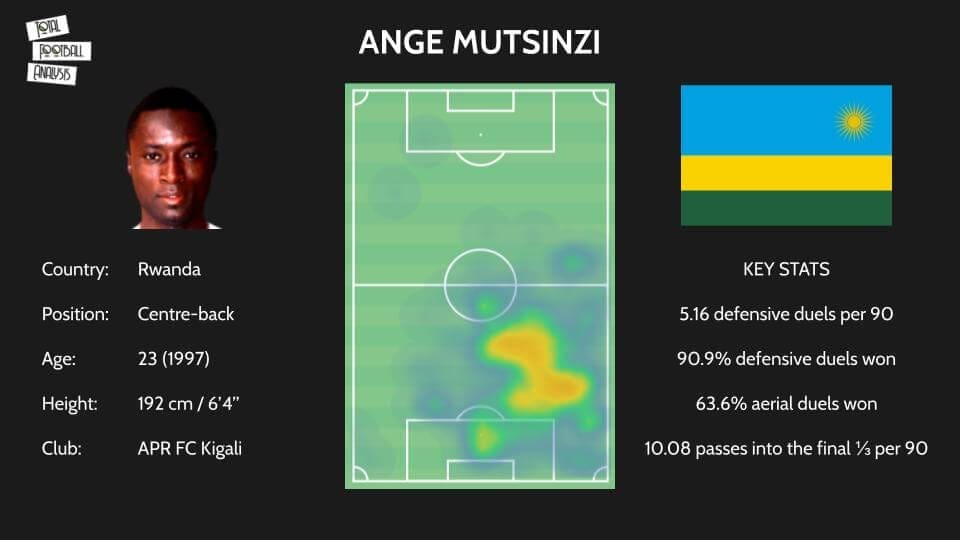
Mutsinzi is a right-footed centre-back who’s usually used on the right side of a back-four. He’s very tall (192 cm / 6’4’’) but still fast and quite mobile. His physicality is fantastic and he outpowers his rivals and uses his strength to win duels.
Very aggressive and determined in one-on-one situations, Mutsinzi times his tackles well and uses his size and strength to win the ball back with ease. He usually stays a step deeper than his centre-back partner and uses his pace to cover the back of the defensive line. He’s almost unstoppable once he starts running and he shows that energy and aggression in his tackles.
When a striker receives with his back to the goal, Mutsinzi is quick to mark him and uses his body to prevent them from turning. Even if they try to dribble out of pressure, he’s mobile enough to react and has the pace to recover if he’s dribbled past. He feels comfortable both defending in a high line and inside the box and would adapt to different tactics.
Mutsinzi is an imposing and physically dominating presence at the back and when he’s at it, he seems impossible to beat. In fact, he only lost 2 of the 22 defensive duels he contested in the African Nations Championship. He’s also powerful in the air, winning most of the aerial duels and making it very difficult for the strikers to get anything positive when they touch the ball. He still makes some risky decisions, especially in his tackles inside the box, but he gets away with it and didn’t make any big mistakes in the tournament.
Very direct with the ball, he usually looks to progress with long passes into the final third for his teammates to fight for the second ball. He has a decent accuracy of 58.1% in his 10.08 passes into the final third per 90. His short and low passes are ok and he doesn’t usually take risks when playing from the back. He should improve the orientation of his clearances as too many of them are aimed at central areas. He would need to adapt to play for a team whose tactics demand playing low passes, drive the ball forward or absorb pressure but his technique isn’t bad and it would be a matter of coaching him right.
Mutsinzi has had a fantastic African Nations Championship, reaching the quarter-finals with Rwanda, and has all the traits to succeed at a higher level. His physicality is second to none and he shows the aggression and passion to defend which are so valuable in a centre-back nowadays. He’s still young and has room and time for improvement.
Salah Fakroun – 22, centre-back, Libya
Salah Fakroun is a 1999-born Libyan defender who plays for Al-Nasr Benghazi in the first division of Libya. Apart from his experience in the local league, Fakroun has played 13 matches in African continental club competitions.
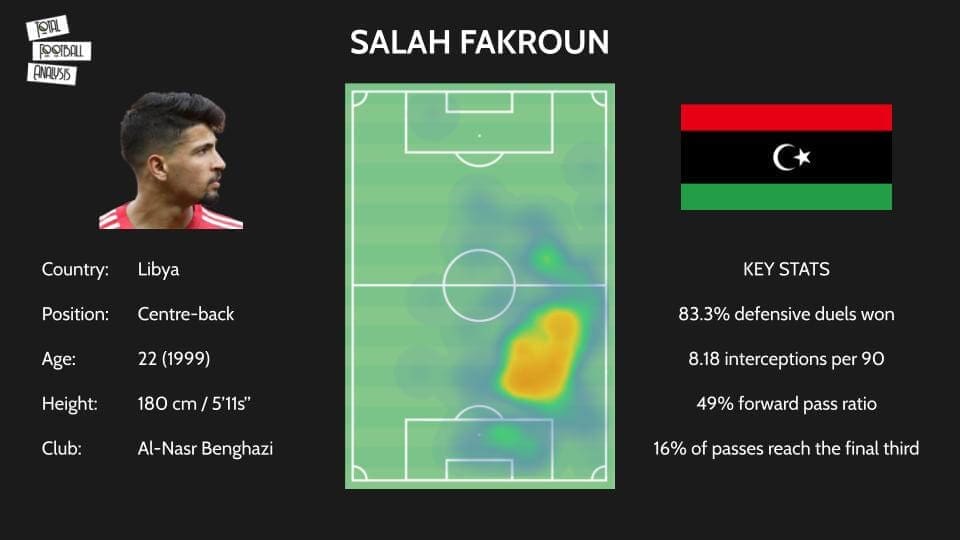
Fakroun is a right-footed centre-back who has been used as the right-sided centre-back in a back three and a back four and also as a right-back. As we’ll see in this analysis, he has the conditions to play in a high line and feels comfortable with spaces behind him so he would fit a high-pressing and attacking team.
Even if he’s not very tall (180 cm) Fakroun has good jump and timing, allowing him to win half of the aerial duels he gets involved in. He also times very well his tackles and has the pace to defend the wings in transitions. Despite not being super strong, Fakroun uses his body very well and is very agile to get himself between the rival and the ball in one-vs-one situations, having won 83.3% of his defensive duels in the African Nations Championship.
His anticipation is excellent, combining good positioning and reading of the game with quickness and reaction. This anticipation is also part of his good aerial game and a way of blocking shots inside the box. This positioning and anticipation translate into his 8.18 interceptions per 90 in the African Nations Championship 2021.
Fakroun possesses a great technique for a centre-back, he plays tense and accurate passes to progress from the back and is very confident to drive the ball forward and dribble out of pressure when he has no passing options. He can also switch the play with good long balls and provide some good crosses from deep when playing as a right-back. 49% of his passes are forward and 16% reach the final third, showing how much he wants to play forward and advance from the defensive line.
Very complete and modern ball-playing centre-back. Fakroun still has time to develop physically into a stronger and tougher defender but he reads the game very well, is great on the ball and has the attitude to impact any team. He would be a very interesting signing for small clubs willing to develop his talents, especially in leagues where teams look to play from the back and use offensive tactics.
Shafiq Kagimu – 22, central midfielder, Uganda
Shafiq Kagimu is a 1998-born Ugandan midfielder who has always played for Uganda Revenue Authority FC in his country’s first division.
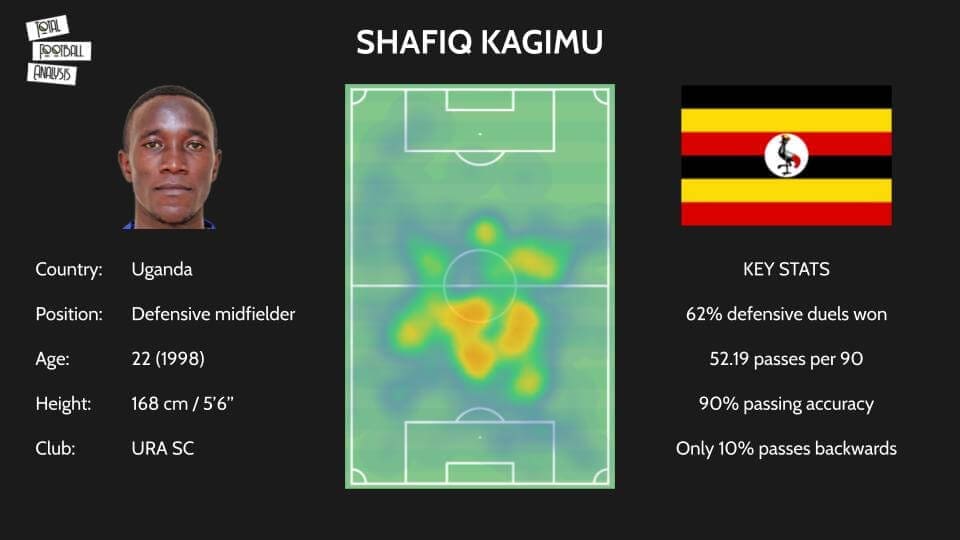
He’s a right-footed central or defensive midfielder who can play in any position in midfield and also on both wings. He’s small (168 cm / 5’6’’), quick and intense in his movements. Not especially strong but very agile and mobile.
In the attacking phase, Kagimu usually stays in a deep position providing safe passing options for his teammates both to build from the back and also to move the ball quickly from side to side. He’s very safe on the ball with a passing accuracy of 90% but tries to play forward or move the ball quickly to the wings and just 10% of his passes are backwards. Kagimu makes his team’s attacks more fluid and doesn’t need many touches to control and pass. He usually uses short passes but can switch the play when needed.
Technically gifted and naturally a more advanced player, Kagimu possesses a very good first touch. He’s quick and skilled to turn and move with the ball in tight spaces to avoid pressure. When under pressure, Kagimu stays very calm and doesn’t rush when making decisions. He transitions quickly from defence to attack, often recovering and passing the ball forward with just one touch. He’s very press resistant, doesn’t feel pressed even when he has the ball inside his box and can find good solutions for every situation.
In defence, Kagimu’s positioning in central areas is very intelligent to prevent counterattacks and when the defenders clear the ball he’s quick and intelligent to get it and restart the attacks. He’s not especially strong in defensive duels but makes up for it with his agility and intensity. He gets first to any loose ball and throws his body between the ball and the opponents to recover possession, which leads to winning over 60% of his defensive duels. He works very hard to cover space in front of the defensive line and doesn’t need a partner to keep the team balanced, leaving the rest of midfielders more freedom to go forward.
Kagimu is a very interesting profile for a defensive midfielder. Because of his size, work rate and ability to play quickly under pressure, he could remind us of Chelsea’s N’Golo Kanté. His adaptation from a more attacking role to a player capable of keeping the balance of his team must be attributed both to the Ugandan coaching staff led by the British duo formed by Jonathan McKinstry and Alex McCarthy and also to the player’s intelligence and adaptability. Any club deciding to go for Kagimu would get a midfielder who’s very young, promising and capable of adapting to different tactics.
Abdoul Darankoum – 18, central midfielder, Niger
Abdoul Darankoum is a 2002-born Nigerien midfielder who plays for Union Sportive de la Gendarmerie Nationale in the Nigerien first division.
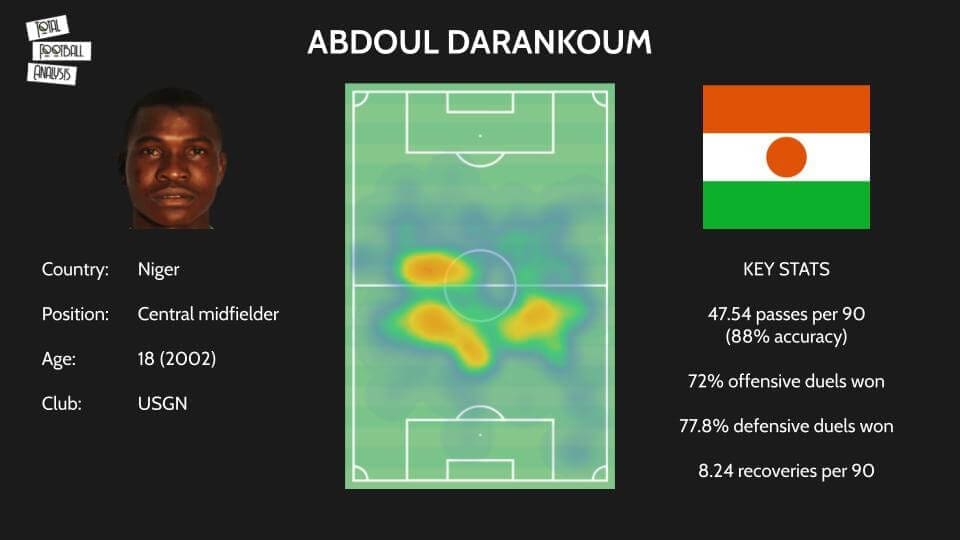
Darankoum is a right-footed central midfielder. Small and agile but very strong in duels, he uses his low centre of gravity to his advantage and wins duels very easily. He’s very vocal on the pitch and is always instructing his teammates regarding where to be positioned or how to move despite being only 18.
He moves from side to side looking to receive the ball and progress from midfield. He always looks to play forward and break lines with his passes, which is good because it helps his team to advance quickly even under pressure but also leads to some mistakes he could avoid if he made better decisions or chose safer passes. Anyway, with a passing accuracy of 88% in his 47.54 passes per 90, Darankoum isn’t a player who loses too many balls.
He has the technique to hit tense passes between rivals and with the correct coaching, Darankoum will learn when to break lines with his passes and when to choose safer options. He has very good delivery from set-pieces and can also hit long balls to switch the play. He has also shown glimpses of his capacity to run with the ball and some nice details to avoid pressure (he wins 72% of the 7.92 offensive duels he disputes per 90). He’s still raw but plays on the front foot and his attitude on the pitch is excellent for a player of his age.
In defence, Darankoum uses his body very well to win the ball back and then hold and protect it and is also good in the air considering his height, winning 64.3% of the 4.44 aerial duels he gets involved in per 90. He’s aggressive and intense when fighting for loose balls which helps him advance even when he doesn’t make the best decision.
Despite his size, Darankoum pushes rivals off the ball very easily and is a very strong player. His physical attributes are exceptional and should continue developing with time and also playing at a higher level. He has won 77.8% of his defensive duels in the African Nations Championship, recovering 8.24 balls per 90 (half of them in the opposition half). He would fit very well in a team that wants to press high and recover the ball close to the rival’s goal.
Darankoum is a raw diamond. He’s a rare kind of player capable of breaking lines while also being a very strong defender. He’s still very young and has lots of time to work on his weaknesses but he has the talent and is ready to play at a higher level to continue developing as a player.
Hamed Belem – 21, left-winger, Burkina Faso
Hamed Belem is a 1999-born forward who plays for Rahimo FC in Burkina Faso. He was supposed to move to USM Alger in Algeria at the end of the tournament but the transfer didn’t go through at the last minute and he will stay in his club for now.
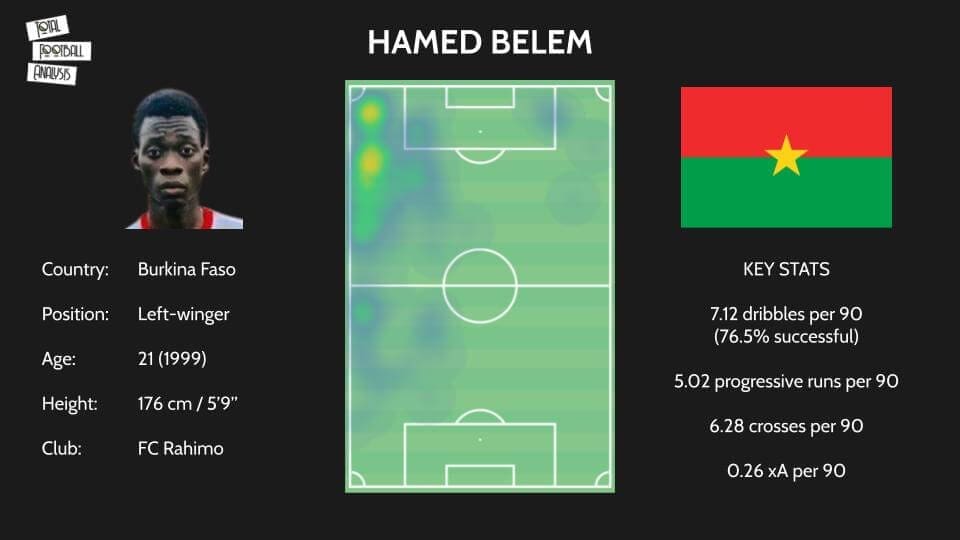
Belem is a left-footed left-winger who stands at 176 cm / 5’9’’. Very fast and explosive, he accelerates very quickly and is difficult to match in short spaces. As we can see in his heatmap, Belem usually stays wide and to exploit his pace from there but that doesn’t mean he always wants the ball to his feet. He also makes lots of well-timed runs in behind, taking advantage of spaces at the back of the full-backs.
Very skilled in one-on-one situations, he has bags of tricks which he combines with his explosiveness to dribble past defenders with ease. Despite being left-footed, Belem doesn’t mind cutting inside to his right foot and isn’t a predictable player. With spaces in front of him, especially in transitions, Belem is almost unstoppable as he just needs to push the ball forward and his pace does the rest. This dribbling ability translates into 7.12 dribbles per 90 with an impressive success rate of 76.5%. His match against Zimbabwe was especially impressive with 10 dribbles and 11 progressive runs.
He looks to cross the ball as soon as he has a yard and doesn’t keep the ball for too long, getting 6.28 crosses per 90. His deliveries into the box are aimed at very good positions. He doesn’t cross just for the sake of it and raises his head to find free teammates, often choosing cut-backs over high crosses. Belem combines quality and quantity to register 0.26 expected assists per 90. A part of his game he could improve is his goalscoring. He doesn’t get into scoring positions often enough and has registered just 5 shots in the whole tournament, all of them in the game against Zimbabwe and from low xG positions (0.036 xG per shot).
Belem is probably the player in this tactical analysis piece who would adapt quickly to a higher level of football. Pace is a universal commodity in world football and he has lots of it. Adding his good decisions to assist and his off-the-ball activity, Belem becomes a raw diamond ready to be taken. USM Alger tried to get him a few days ago and it wouldn’t be surprising if he moves to a better league in the next transfer window.
Conclusion
The African Nations Championship is one of the most entertaining and interesting tournaments in the world. Being able to watch lots of new players is great for fans and scouts alike and Africa consistently produces some of the best talents in the world.
Of course, it would be risky for clubs at a high level to sign a player just based on his performance in this tournament but the potential gains are huge compared to the costs. Any club that scouts this tournament in-depth will surely find some talents that they believe are worth a gamble. Coming from leagues in which sometimes €250 per week is a very high salary, the risk is worth taking and if the player performs at just an acceptable level it would be a recruitment success.

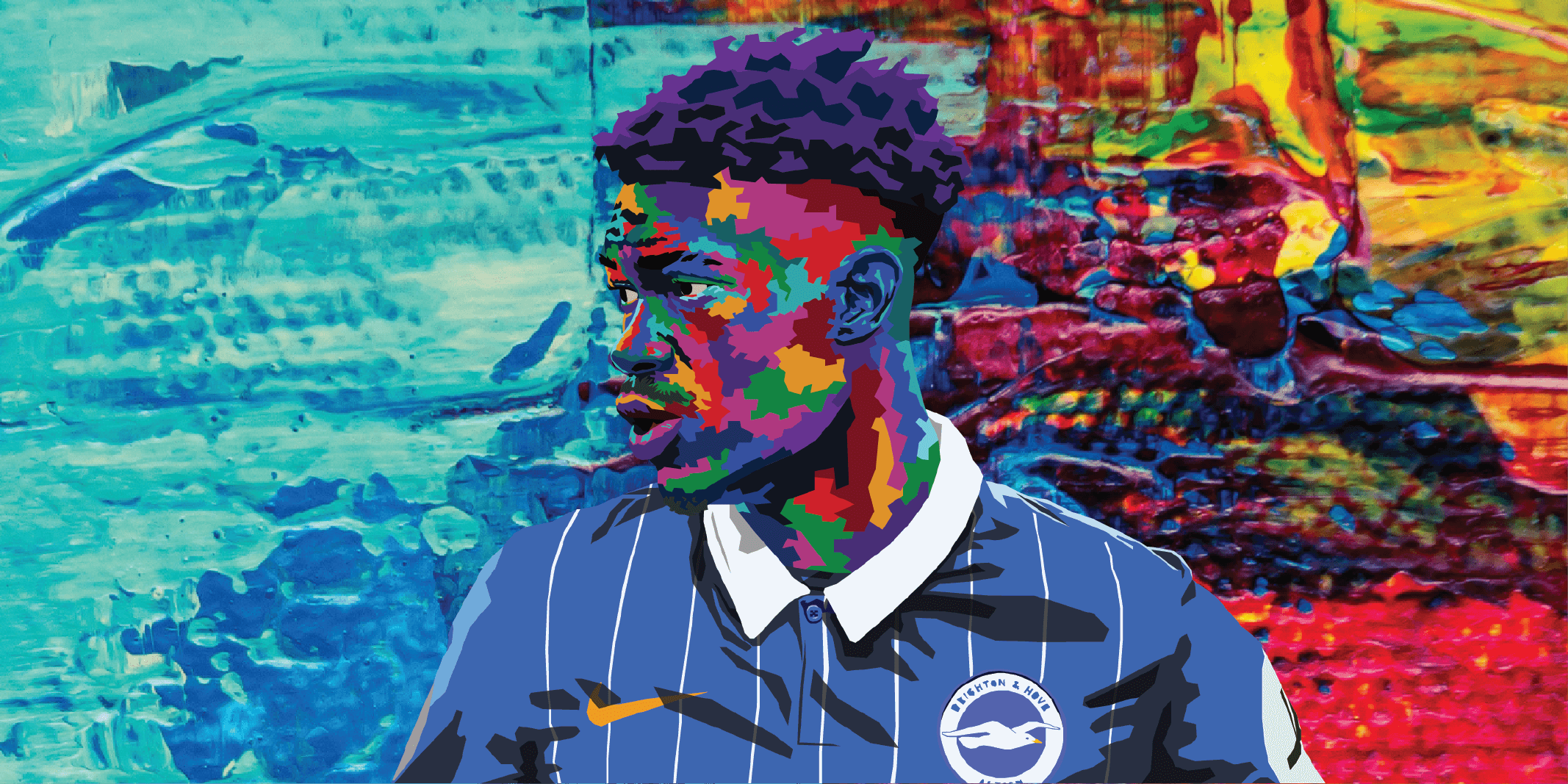



Comments